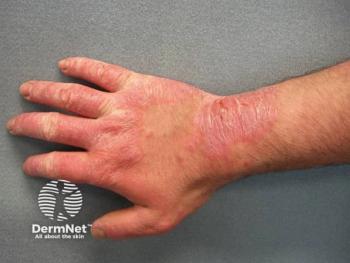
- Dermatology Times, August 2025 (Vol. 46. No. 08)
- Volume 46
- Issue 08
Practical Guidance for Utilizing Dermatology Times Event Systemic Therapies in Atopic Dermatitis
Key Takeaways
- AD affects 20% of pediatric and 10% of adult populations, with significant quality of life impacts due to symptoms like itch and sleep disturbances.
- Personalized treatment approaches are vital, considering age-specific presentations, comorbidities, and patient preferences, such as needle aversion.
Explore personalized systemic therapies for atopic dermatitis, addressing patient needs, treatment options, and enhancing adherence for better outcomes.
"Although we've had excellent advances in atopic dermatitis, there are still some unmet needs," shared Tiffany Mayo, MD, who recently led a comprehensive, case-driven discussion on systemic therapies in atopic dermatitis (AD).
Mayo, an associate professor of dermatology and director of dermatology clinical research at the University of Alabama at Birmingham, hosted a Dermatology Times Case-Based Peer Perspective custom video series Navigating the Atopic Dermatitis Treatment Landscape: Personalized Treatment Approaches to Systemic Therapy. She emphasized individualized patient care, emerging treatment options, and practical pearls to improve outcomes across age groups, disease presentations, and comorbidities.
Understanding Burden of Disease Across the Lifespan
According to Mayo, AD affects an estimated 20% of pediatric patients and 10% of adults worldwide, but prevalence alone does not reflect the true disease burden.
“When we’re thinking about the impact of disease, we really have to think about how it affects our patients,” Mayo said. “In terms of physically, we know that atopic dermatitis can cause inflammation on the skin, fissures in the skin, pain of the skin, and, specifically, we know that itch is 1 of the main symptoms that patients are bothered by.”
Sleep disturbance also remains a prevalent concern for patients. “We cannot forget about sleep,” Mayo said. “Our patients with atopic dermatitis have interruptions in sleep that impact their overall quality of life.”
Age-specific presentations can also affect diagnosis and management. “In our adolescent patients, we actually may see the more common flexural areas, whereas in the infants it actually may be more extensive...and in our adult patient population, we actually see more of an acral distribution,” Mayo explained.
Case No. 1: Pediatric Patient with Severe AD and ADHD Symptoms
Mayo presented the case of a 5-year-old boy who presented with persistent severe itch, frequent nighttime wakings, and difficulty concentrating in school, despite adherence to topical therapy.
“This is something that really should lead us to start thinking about more appropriate systemic treatment options,” Mayo said. “Sleep disturbance can really impact our patients, especially our pediatric patient population.”
In this case, dupilumab was selected as the treatment of choice, with Mayo noting its efficacy in treating AD while exhibiting benefits in asthma, as well.
On starting systemic therapy, Mayo advised, “I ask the patients and parents to continue their current regimen until the patient has experienced significant improvement, and then we taper off of our topical therapies.”
Case No. 2: Newly Diagnosed Adult with AD and Comorbidities
A 55-year-old Black man presented with chronic itch and hyperpigmented plaques, as well as comorbid diabetes, hypertension, and chronic kidney disease.
“Immediately, I know this is an adult patient who actually has not had atopic dermatitis all his life—or maybe he has and did not know it,” Mayo said. “We don’t want to underrecognize how hesitancy can impact [adherence].”
Delayed diagnosis in adults, particularly in patients with skin of color, can lead to poor outcomes. “Erythema is 1 of the highlighting features used to diagnose atopic dermatitis,” Mayo said. “Now, in skin-of-color patients, instead of seeing bright red erythema, patients may actually present with more hyperpigmentation.”
This patient initiated treatment with dupilumab due to his comorbidities and hesitancy about JAK inhibitors. Mayo highlighted the clinical need to address hyperpigmentation expectations, saying, “It’s also important for patients to know that hyperpigmentation is a result of their inflammatory skin disease and not a result of the medication.”
Case No. 3: Adult With Injection Aversion and Hand Involvement
A 42-year-old Latina florist presented with worsening hand and facial AD with significant psychosocial burden. She had previously discontinued lebrikizumab due to injection anxiety.
“Regardless of whether the patient has atopic dermatitis anywhere else, this should automatically make us consider this disease severe…and consider systemic therapies,” Mayo said.
Given her strong preference against injectables, the patient was started on oral abrocitinib. “We seriously need to consider [needle] aversion,” Mayo noted. “Needle phobia is a common issue…even up to 20 to 30% of adults may have needle phobia or anxiety. We have excellent, effective, and safe oral therapies in our JAK inhibitors that the patient can try.”
Clinical Pearls for Adherence, Safety, and Shared Decision-Making
Mayo said patient-centered care and education are crucial to ensuring treatment success, particularly with systemic agents. For pediatric adherence, Mayo recommends utilizing tools such as ice to numb affected areas or employing vibration tools to create a distraction, vs holding young patients down, which induces significant anxiety.
With oral JAK inhibitors, Mayo recommends keeping a calendar for young patients and using a star-based system to remind the patient and reward them when they take their medication.
Beyond adherence, safety discussions are essential. “Biologic agents are quite safe for our patients, but…it’s important to specifically discuss postinflammatory hyperpigmentation in any skin of color patient,” Mayo said.
Regarding JAK inhibitors, Mayo clarified that outlining black box warnings ahead of time can put patients at ease.
Final Thoughts
Mayo concluded by emphasizing the importance of tailoring treatment to the individual.
“A few takeaways: We have numerous treatment options for our patients with atopic dermatitis. It’s important to consider all of these treatment options and select the appropriate therapy for the patient. The appropriate therapy for the patient may not necessarily align with body surface area,” she said. “We want to pick the absolute best one for our patients. However, we have to consider the patient in making this decision.… In order to have patients be compliant, we have to include them in the discussion.”
Articles in this issue
3 months ago
Examining Bond-Building Hair Care Treatments4 months ago
Dermatology Times August 2025 Print RecapNewsletter
Like what you’re reading? Subscribe to Dermatology Times for weekly updates on therapies, innovations, and real-world practice tips.



















